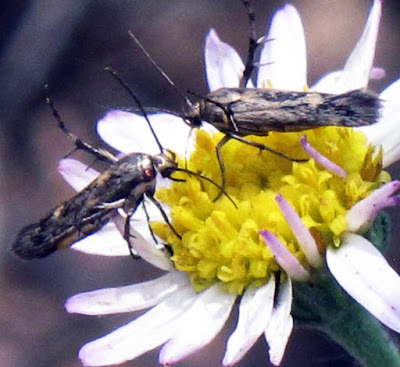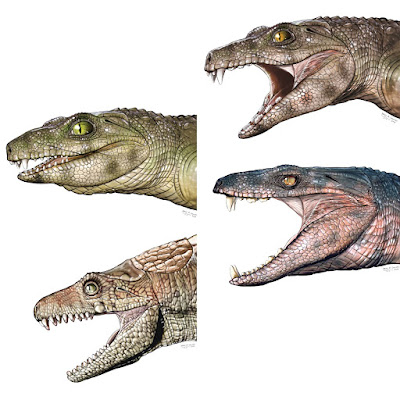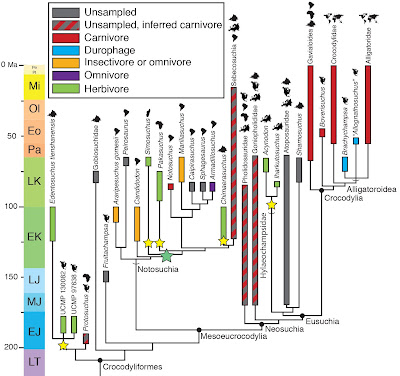[Most Recent Entries] [Calendar View]
Friday, June 28th, 2019
| Time | Event | ||||
| 2:09a | [Herpetology • 2019] Lost and Found: Taxonomic Revision of the Speckled Skink (Oligosoma infrapunctatum; Reptilia; Scincidae) Species Complex from New Zealand reveals A Potential Cryptic Extinction, Resurrection of Two Species, and Description of Three
Abstract New Zealand has a diverse skink fauna, comprising 45 described native species, and at least 15 undescribed taxa, within the single genus Oligosoma Girard, 1857. One of the earliest described, and best known, species is the speckled skink, Oligosoma infrapunctatum (Boulenger 1887). Despite a relatively stable taxonomic history for nearly 114 years, recent molecular work has indicated that O. infrapunctatum represents a species complex, comprising numerous genetically divergent, range restricted taxa. We completed the first stage of a taxonomic revision of O. infrapunctatum, conducting a morphological re-evaluation of existing voucher material, and newly collected specimens, and generated a molecular phylogeny for the species complex. This allowed us to distinguish six species: O. infrapunctatum, two species resurrected from synonymy (O. newmani, O. robinsoni), and three new species (O. salmo sp. nov., O. albornense sp. nov. O. auroraensis sp. nov.). The name bearing type population of O. infrapunctatum has not been located again for at least 130 years: it remains to be rediscovered and may already be extinct. Two of the six species here are considered ‘Nationally Critical’ (O. albornense sp. nov., O. salmo sp. nov.) under the New Zealand Threat Classification System, the others are Nationally Vulnerable (O. auroraensis sp. nov.) and At Risk—Relict (O. newmani, O. robinsoni). Further taxonomic work will be required to determine the taxonomy of other speckled skink genetic lineages in the South Island, particularly O. aff. infrapunctatum “cobble”, O. “Hokitika”, O. “Southern North Island” and O. “Westport”. Keywords: Reptilia, cryptic species, morphology, taxonomy, speckled skink, Oligosoma infrapunctatum, newmani, salmo sp. nov., auroraensis sp. nov., albornense sp. nov., robinsoni, Chesterfield skink Sabine Melzer, Rod A. Hitchmough, Trent Bell, David G. Chapple and Geoff B. Patterson. 2019. Lost and Found: Taxonomic Revision of the Speckled Skink (Oligosoma infrapunctatum; Reptilia; Scincidae) Species Complex from New Zealand reveals A Potential Cryptic Extinction, Resurrection of Two Species, and Description of Three New Species. Zootaxa. 4623(3); 441–484. DOI: 10.11646/zootaxa.4623.3.2 | ||||
| 3:36a | [Entomology • 2019] Taxonomic Study of the Genus Eretmocera Zeller, 1852 (Lepidoptera: Scythrididae) from China, with Descriptions of Three New Species
Abstract Four species of the genus Eretmocera Zeller, 1852 from China are reviewed. Three species are described as new: Eretmocera yingjiangensis Li, sp. nov., E. octopunctata Li, sp. nov. and E. artemisiae Li, sp. nov. Eretmocera impactella (Walker, 1864) is redescribed based on specimens founded on Yunnan, China. Photographs of adults and genitalia are provided, and a key to the Eretmocra species that occur in China is given. Keywords: Lepidoptera, Gelechioidea, flower moth, key, redescription Kang Lou, Dian Yu, Wanxue You and Houhun Li. 2019. Taxonomic Study of the Genus Eretmocera Zeller, 1852 (Lepidoptera: Scythrididae) from China, with Descriptions of Three New Species. Zootaxa. 4624(2); 205–218. DOI: 10.11646/zootaxa.4624.2.4 | ||||
| 10:32a | [Paleontology • 2019] Repeated Evolution of Herbivorous Crocodyliforms during the Age of Dinosaurs
Highlights • Some extinct crocodyliforms, relatives of living crocodylians, possess complex teeth • Quantitative analyses suggest some species with complex teeth were likely herbivores • Herbivorous crocodyliforms evolved at least three times independently • Some dentitions rival the complexities of living mammal herbivores Summary Extinct crocodyliforms from the age of dinosaurs (Mesozoic Era) display an impressive range of skeletal morphologies, suggesting a diversity of ecological roles not found in living representatives. In particular, unusual dental morphologies develop repeatedly through the evolutionary history of this group. Recent descriptions of fossil crocodyliforms and their unusual teeth provide the inferential basis for a wide range of feeding ecologies. However, tests of these hypotheses are hindered by the lack of directly comparable dental morphologies in living reptiles and mammals, thereby preventing an accurate ecosystem reconstruction. Here, we demonstrate, using a combination of the orientation patch count rotated method and discrete morphological features, that Mesozoic crocodyliforms exploited a much greater range of feeding ecologies than their extant relatives, including likely omnivores and herbivores. These results also indicate that crocodyliforms independently developed high-complexity dentitions a minimum of three times. Some taxa possess teeth that surpass the complexities of living herbivorous lizards and rival those of omnivorous and herbivorous mammals. This study indicates that herbivorous crocodyliforms were more common than previously thought and were present throughout the Mesozoic and on most continents. The occurrence of multiple origins of complex dentitions throughout Crocodyliformes indicates that herbivory was a beneficial dietary strategy and not a unique occurrence. Many of these crocodyliforms lived alongside omnivorous or herbivorous synapsids, illustrating an ecological partition that is not observed today. Keywords: diet, dental complexity, mesozoic, paleoecology
Keegan M. Melstrom and Randall B. Irmis. 2019. Repeated Evolution of Herbivorous Crocodyliforms during the Age of Dinosaurs. Current Biology. DOI: 10.1016/j.cub.2019.05.076 Some extinct crocs were vegetarians phys.org/news/2019-06-extinct-crocs-vege |
| << Previous Day |
2019/06/28 [Calendar] |
Next Day >> |











